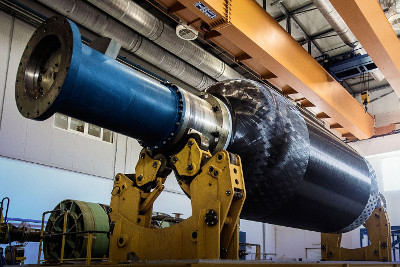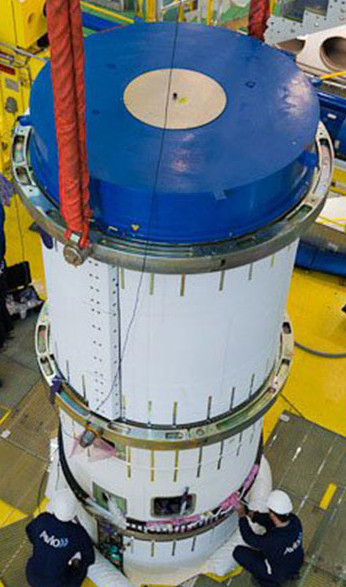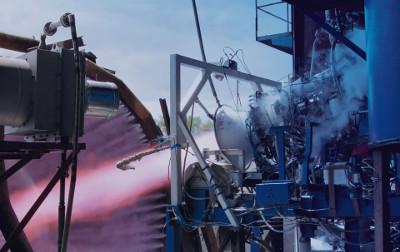Updated: 03-Oct-2018
AVIO is coming from the recovery of BPD Difesa & Spazio Passing through Fiat-Avio.
It forms part of the European space consortium "Europropulsion Inc.", formed by Snecma / Safran and the AVIO itself.
-It is active in the VEGA and Ariane projects with the following engines:
-The P80 that is used in the first stage of the first Vega project weighs 95 tons and burns 88 tons of solid fuel in less than 2 minutes.

"P80"
-In the second stage of the VEGA project, the Zefiro 23 engine is used. It weighs 26 tons, of which 24 tons are solid propellant. It gives an average thrust of 1,122 kN.

"Zefiro 23"
-The Zefiro 9 is used in the third stage of this spacecraft. This engine weighs 11.5 tons and burns 9 tons of solid fuel. It gives an average thrust of 314 kN.

"Zefiro 9"
-The fourth stage of the VEGA is the AVUM module, which has an engine based on the RD-843 designed by Yuzhnoye Design Bureau and manufactured by Yuzmash (see). It is a liquid fuel rocket engine.
-The first stage of the VEGA-C project uses the P120C engine which is a derivation of the P80. Avio works together with the Ariane Group in the development of this engine. Like its predecessor, the structural housing is made of carbon fiber. It will contain 141 tons of solid propellant.

"P120C"
-During this year 2018, the P120C has been successfully tested in the polygon of Kourou.
-The Zefiro 40 (Z40) is used in the second stage of this project. In 2011 Avio began to develop this engine to surpass the performance of the Zefiro 23. It gives an average thrust of 1304 kN during 92.9 seconds.
-As in the first VEGA proyect, the Zephiro 9 is also used in the third stage of the VEGA-C project.
-The fourth stage of VEGA C consists of the AVUM + module that carries an RD-869 engine. This engine is specially designed for this project by Yuzhnoye Design Bureau and manufactured by Yuzmash.
-The next project, VEGA-E, is in progress to begin in 2024.
-It will be a three-stage spacecraft. The same engines will be used in the first two stages, the P120C and the Z40.
-The third stage will be the "Mira Motor" or M10. It is an engine with an innovative liquid fuel system of LOX/CH4. This new engine gives a thrust of around 10 tons.

"Test with the Mira Motor"
-AVIO also collaborates in the boosters of the Ariane 5 project. The booster engine weighs 269.4 tons, delivers a maximum vacuum thrust of 6,996 MN for 129 seconds.
-On the Ariane 6, the P120C motor, which we have already seen in the VEGA C and E project, is also used.
-AVIO also designs and produces liquid-fuel turbo-pumps for rocket engines.
-The Mira Motor uses the Mira-D turbo-pump.
-The Ariane 5 used the Vulcain 1 turbo-pump.
-The Ariane 6 had two turbo pumps, the Vulcain 2 and the Vinci.
Engines of AVIO
Model: Avum+ engine (Evolución del RD-869)
Arquitecture: Rocket engine
Chambers:
Fuels:
Feed System:
Ignition:
Thrust:
Weight:
Model: Mira motor
Arquitecture: Rocket engine
Chambers:
Fuels:
Feed System:
Ignition:
Thrust: 98 kN
Weight:

"Avio Mira Motor test"
Model: P120C
Arquitecture: Rocket engine
Chambers:
Fuels:
Feed System:
Ignition:
Thrust: 4500 kN
Weight:

"P120C"
Model: P80
Arquitecture: Rocket engine
Chambers:
Fuels:
Feed System:
Ignition:
Thrust: 3015 kN
Weight: 7330 Kg

"Motor Vega P80"
Model: RD-843 (Avum module)
Arquitecture: Rocket engine
Chambers:
Fuels:
Feed System:
Ignition:
Thrust:
Weight:
Model: Zefiro 23
Arquitecture: Rocket engine
Chambers:
Fuels:
Feed System:
Ignition:
Thrust: 1122 kN
Weight:

"Zefiro 23"
Model: Zefiro 40 (Z40)
Arquitecture: Rocket engine
Chambers:
Fuels:
Feed System:
Ignition:
Thrust: 1304 kN
Weight:
Model: Zefiro 9
Arquitecture: Rocket engine
Chambers:
Fuels:
Feed System:
Ignition:
Thrust: 314 kN
Weight:

"Zefiro 9"


